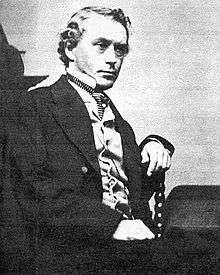George Templeton Strong
George Templeton Strong (January 26, 1820 – July 21, 1875) was an American lawyer and diarist. His 2,250-page diary, discovered in the 1930s, provides a striking personal account of life in the 19th century, especially during the events of the American Civil War. The historian Paula Baker described him as "perhaps the northern equivalent of South Carolina's Mary Chesnut: quotable, opinionated, and a careful follower of events."
George Templeton Strong | |
|---|---|
 George Templeton Strong c. 1870 | |
| Born | January 26, 1820 50 Franklin Street, New York City |
| Died | July 21, 1875 (aged 55) |
| Nationality | American |
| Occupation | Lawyer |
Life and career
Strong was born at 50 Franklin Street, New York City, at 7 o'clock on the morning of Wednesday, January 26, 1820.[1][2] He lived to write intimately of the turbulent years leading up to and through the American Civil War, as well as the corrupt and turbulent years in New York following the war.
He received his early education from Columbia Grammar & Preparatory School (then known as "Columbia Grammar School"). In 1838 he graduated from Columbia College[2] with high honors and served as president of the Philolexian Society. That same year he joined the law practice of his father that became Cadwalader, Wickersham & Taft. Today it is the nation's oldest operating law firm. On May 15, 1848, Strong married Ellen Ruggles in Grace Church, New York. A gifted amateur singer, she was the daughter of Samuel B. Ruggles. In 1853, Strong was elected a trustee of Columbia College.
Strong served for many years as a vestryman at the prominent Episcopal Trinity Church on Wall Street. Strong helped found the United States Sanitary Commission, which helped ameliorate the sufferings of wounded soldiers during the American Civil War. He was also treasurer and member of its executive committee throughout the war. He also helped to start the Union League Club of New York, an organization which pledged to "cultivate a profound national devotion." The organization provided a means to reconciling the whites and blacks of the South into the Republican Party. Strong funded a Union Army regiment during the war, and Ellen Strong served on a hospital ship. He avoided military service by simply taking advantage of that section of the Enrollment Act of 1863 allowing draftees to pay $300 to a substitute who served for them. This amount, a healthy sum in 1863, did not long remain the norm, for George Templeton Strong, pluckier than many of his contemporaries, paid a "big 'Dutch' boy of about twenty" $1,100 to be his "alter ego" in 1864.
Strong's 2,250-page diary, now in the collections of the New-York Historical Society, whose first entry was recorded on October 5, 1835, was discovered in the 1930s. Beginning at the age of fifteen, Strong wrote almost every day of his life for nearly forty years. Excerpts from this diary are featured in Ken Burns 1990 documentary The Civil War and in Ric Burns's New York: A Documentary Film. Extensive selections from the diary were published in four volumes in 1952, and remain of interest to historians of New York City, as well as to bibliographic collectors.
The family was musical, and both Strong and his wife performed as amateurs. He served as President of the New York Philharmonic Society for several years. Their son, also named George Templeton Strong (1856–1948), became a noted Romantic composer and painter, but was early estranged from his father. Although he had most of his career in Europe after moving to Switzerland in the late nineteenth century, the younger Strong is considered an American composer.
See also

References
- Strong, George Templeton (1952). Nevins, Allan; Thomas, Milton Halsey (eds.). The Diary of George Templeton Strong. I. New York: Macmillan Company. p. 157.
- Daniel Aaron (March 1988). "The Greatest Diarist". American Heritage Magazine. 39 (2).
External links
- Guide to the Strong Family Papers, 1747–1940
- John C. Willis, "George Templeton Strong", America's Civil War: History 393, University of the South- Sewanee
- Mr. Lincoln and New York
- Infography about George Templeton Strong
- Civil War Draft Records: Exemptions and Enrollments
- "George Templeton Strong". Find a Grave. Retrieved 2009-04-15.